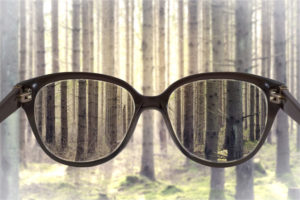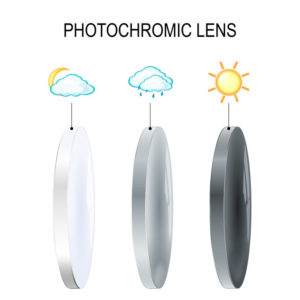Sick of playing musical glasses?
Do you get tired of having to carry around both prescription glasses and sunglasses and then switching between the two every time the sun comes out? Then you will definitely benefit from wearing Transition Sensity photochromic lenses. Designed for people on the go, these are smart lenses that seamlessly change when you move from indoors to outdoors, ensuring maximum visual comfort in all settings.
 By helping your eyes adjust to shifting light conditions, photochromic lenses let you discern objects of different size, contrast and brightness. You will see better in all light conditions.
By helping your eyes adjust to shifting light conditions, photochromic lenses let you discern objects of different size, contrast and brightness. You will see better in all light conditions.
Good for all sorts of vision problems, light-reactive lenses can be used in single vision lenses and progressive lenses, and they come in different designs, colours and materials, ranging from standard to scratch and shatter-resistant materials.
Busy? Always in and out and on the move? Wearing Transition Sensity photochromic lenses means that instead of mucking around with prescription sunnies or chopping and changing your eye glasses, you can relax, well, about your glasses anyway.
How do photochromic lenses work?
Light reactive lenses, also known as photochromic lenses, interact dynamically with the environment; they instantly detect the presence of UV rays and change accordingly to protect the eyes. They darken in bright sunlight and then fade back to clear when you’re indoors. They protect the eyes by absorbing harmful UV light, known to contribute to cataracts, macular degeneration and eyelid tumours. These lenses essentially mean you can wear eyeglasses and sunglasses at the same time.
That’s pretty clever, but how do they know what to do?
 These lenses contain a photochromic substance that undergoes a reversible change in colour on exposure to light. Great, but what does that mean?
These lenses contain a photochromic substance that undergoes a reversible change in colour on exposure to light. Great, but what does that mean?
Light reactive lenses are made with a photochromic dye. When exposed to sufficient light, or UV radiation, the glasses will tint, and then at night-time or when there is no ultraviolet light, the lenses appear clear. Tinting increases with light intensity.
Who can wear photochromic lenses?
 They are suitable for all age groups, especially kids. The crystalline lenses in children’s eyes are young and not yet fully developed. Light reactive lenses cut out the potentially damaging ultraviolet rays when kids are busy enjoying the outdoors.
They are suitable for all age groups, especially kids. The crystalline lenses in children’s eyes are young and not yet fully developed. Light reactive lenses cut out the potentially damaging ultraviolet rays when kids are busy enjoying the outdoors.
What are the benefits of light reactive lenses?
- They offer full UV protection in all climates and seasons.
- You’ll have comfortable vision, no matter the light intensity.
- Cut your squint. Your glasses will darken rapidly when outdoors and fade back quickly to clear when indoors. Within 35 seconds of exposure to the sun, they can reach 70% tint.
- They help reduce glare, eye fatigue and eye strain because your eyes are protected against constant variations in light.
- These lenses are recommended for people with specific eye conditions, such as cataracts, that affect night vision, contrast and light sensitivity.
Are photochromic lenses the perfect alternative to sunglasses?
Not completely. Even at their very darkest, photochromic lenses don’t generally get as dark as good sunglasses would. In addition, sun protection is also about how large the lens is. The bigger your lenses, the better the protection.
For outdoor activities involving extreme glare, like walking on the beach or snowboarding, a pair of dark sunglasses with proper eye coverage will always be best. Fashionable, optical frames are typically reasonably small in size, allowing stray ultraviolet light from the top, bottom and the sides to slip through. If you’re going to spend time outside in a glary environment, you are better off wearing large wrap-around, polarised sunglasses.
We receive 40% of UV radiation when we least expect it, like on cloudy days or over winter. Photochromic lenses can be a useful add on to prescription glasses. They provide UV and glare protection around the clock for people on the go who need indoor and outdoor glasses and want to get on with life without constantly changing them.
Are they good driving glasses?
Photochromic lenses go darkest in cool conditions. They also need exposure to UV light to activate, which is largely blocked by car windscreens.
If you spend a lot of time behind the wheel, a pair of dark polarised lenses will give you the best comfort.
Transition Sensity photochromic lenses for life
Photochromic lenses offer great lifestyle benefits. They are convenient, and by handling much of the day-to-day variation in light conditions, they protect your eyes from glare and UV light.
If you spend much of your time indoors, but you would like the convenience of some protection from glare and UV as you’re in and out and on the move, then a photochromic lens is best for you. However, they are best supplemented with sunglasses for prolonged driving and outdoor activities like skiing, fishing or lying around on the beach.
Photochromic lenses for me?
Eye glasses come in many forms, shapes and sizes. When you have a wide range of options before you, choosing which glasses to wear can be tricky. Want to know more about choosing the best UV and glare protection for your eyes? Interested in Transitions photochromic lenses as part of your vision correction solution?
At John O’Connor Optometrists we stock HOYA Sensity, the latest innovation in photochromic lenses that provides unparalleled performance and outstanding user comfort. We also stock a massive range of fashionable and practical frames, which can be custom designed to suit your lifestyle and visual needs. Talk to our eye experts. They’ll help you choose the right lenses for your lifestyle and frames for your face.
To see the everyone in their best light, come and talk to us or call 09 522 1283 to speak to our Newmarket optometrists. To speak to an optometrist in Henderson call 09 836 1731.

